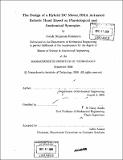The design of a hybrid DC motor/SMA actuated robotic hand based on physiological and anatomical synergies
Author(s)
Rosmarin, Josiah Benjamin
DownloadFull printable version (58.54Mb)
Other Contributors
Massachusetts Institute of Technology. Dept. of Mechanical Engineering.
Advisor
H. Harry Asada.
Terms of use
Metadata
Show full item recordAbstract
A new approach to the design and control of multi-fingered hands using hybrid DC motor-Shape Memory Alloy (SMA) array actuators is presented in this thesis. The fundamental design concept is based on the principle of motor control synergy, a biomechanics terminology for coordinated motion generation. Principal component analysis is used for determining the most significant direction as well as the residual directions. A single DC motor is used for driving multiple fingers at a particular velocity distribution over a vast number of finger joints corresponding to the direction of the most significant synergy. SMA array actuators are used for driving the fingers in the residual directions. Although many actuator axes are needed for spanning the residual space, the required strokes are much shorter than the most significant direction; compact and high energy-density SMA actuators meet these requirements. The thesis presents synergistic integration of these two types of actuators having diverse characteristics. This allows us to embed all the actuators and transmission mechanisms in the palm, eliminating a bundle of tendons crossing over the wrist joints. An initial prototype hand is designed and built.
Description
Thesis (S.M.)--Massachusetts Institute of Technology, Dept. of Mechanical Engineering, 2008. Includes bibliographical references (p. 73-74).
Date issued
2008Department
Massachusetts Institute of Technology. Department of Mechanical EngineeringPublisher
Massachusetts Institute of Technology
Keywords
Mechanical Engineering.